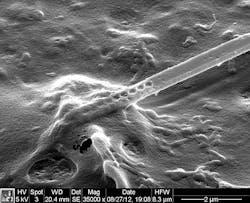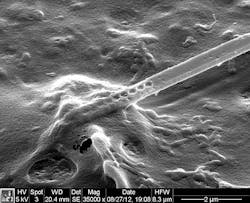Light-emitting bioprobe fits in a single cell
Engineers at Stanford University (Stanford, CA) have developed light-emitting probes that are small enough to be injected into individual cells without harm to the host. Their study is the first to demonstrate that light resonators can be inserted inside cells without damaging them, and cells containing their bioprobe are able to function, migrate, and reproduce as normal.
The researchers call their device a "nanobeam" because it resembles a steel I-beam with a series of round holes etched through the center. The nanobeam measures only a few microns in length and just a few hundred nanometers in width and thickness. The holes, or photonic cavities, through the beam focus and amplify light at the center of the beam.
"Devices like the photonic cavities we have built are quite possibly the most diverse and customizable ingredients in photonics," says the paper's senior author, Jelena Vuckovic, a professor of electrical engineering. "Applications span from fundamental physics to nanolasers and biosensors that could have profound impact on biological research."
At the cellular level, a nanobeam acts like a needle able to penetrate cell walls without injury. Once inserted, the beam emits light, yielding a remarkable array of research applications and implications. While other groups have shown that it is possible to insert simple nanotubes and electrical nanowires into cells, nobody had yet realized such complicated optical components inside biological cells.
"We think this is quite a dramatic shift from existing applications and will enable expanded opportunities for understanding and influencing cellular biology," says the paper's first author, Gary Shambat, a doctoral candidate in electrical engineering. Shambat works at the Nanoscale and Quantum Photonics Lab directed by Vuckovic.
In this case, the studied cells came from a prostate tumor, indicating possible application for the probe in cancer research. The primary and most immediate use would be in the real-time sensing of specific proteins within the cells, but the probe could be adapted to sense any important biomolecules, such as DNA or RNA.
To detect these key molecules, researchers coat the probe with certain organic molecules or antibodies that are known to attract the target proteins, just like iron to a magnet. If the desired proteins are present within the cell, they begin to accumulate on the probe and cause a slight-but-detectable shift in the wavelength of the light being emitted from the device. This shift is a positive indication that the protein is present and in what quantity.
"Let's say you have a study that is interested in whether a certain drug produces or inhibits a specific protein. Our biosensor would tell definitively if the drug was working and how well, based on the color of the light from the probe. It would be quite a powerful tool," explains Sanjiv Sam Gambhir, co-author of the paper and chair of the Department of Radiology at the Stanford School of Medicine as well as director of Stanford's Canary Center for Cancer Early Detection. As such, embeddable nanoscale optical sensors would represent a key development in the quest for personalized medicine.
Structurally, the new device is a sandwich of extremely thin layers of gallium arsenide (GaAs) alternated with similarly thin layers of quantum dots. The structure is carved out of chips or wafers; once carved, the devices remain tethered to the thick substrate.
For biological applications, the thick, heavy substrate presents a serious hurdle for interfacing with single cells. The underlying and all-important nanocavities are locked in position on the rigid material and unable to penetrate cell walls. So Shambat's breakthrough came when he was able to peel away the photonic nanobeams. He then glued the ultrathin photonic device to a fiber-optic cable with which he steers the needle-like probe toward and into the cell. Once inserted in the cell, the probe emits light, which can be observed from outside. For engineers, it means that almost any application of these powerful photonic devices can be translated into the previously off-limits environment of the cell interior.
In one finding that the authors describe as stunning, they loaded their nanobeams into cells and watched as the cells grew, migrated around the research environment, and reproduced. Each time a cell divided, one of the daughter cells inherited the nanobeam from the parent and the beam continued to function as expected. This inheritability frees researchers to study living cells over long periods of time, a research advantage not possible with existing detection techniques, which require cells be either dead or fixed in place.
"Our nanoscale probes can reside in cells for long periods of time, potentially providing sensor feedback or giving control signals to the cells down the road," says Shambat. "We tracked one cell for eight days. That's a long time for a single-cell study."
For more information on the work, which appears in Nano Letters, please visit http://pubs.acs.org/doi/abs/10.1021/nl304602d.
-----
Follow us on Twitter, 'like' us on Facebook, and join our group on LinkedIn
Subscribe now to BioOptics World magazine; it's free!

